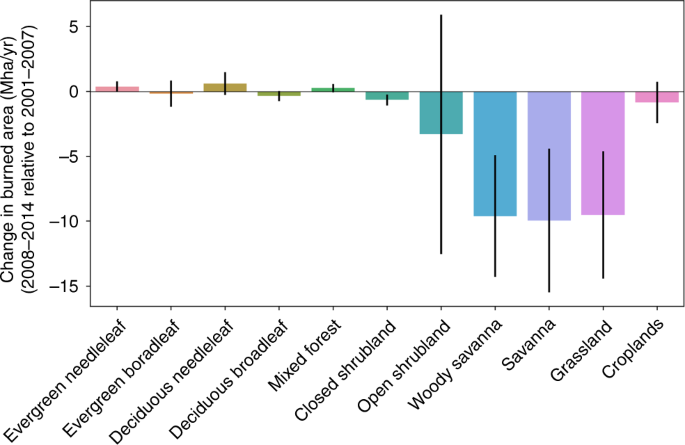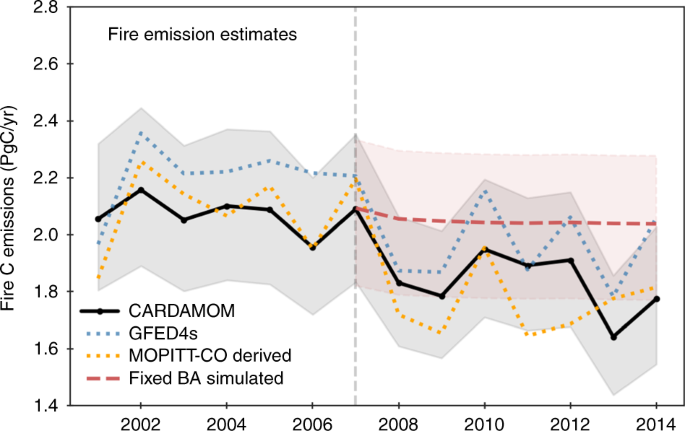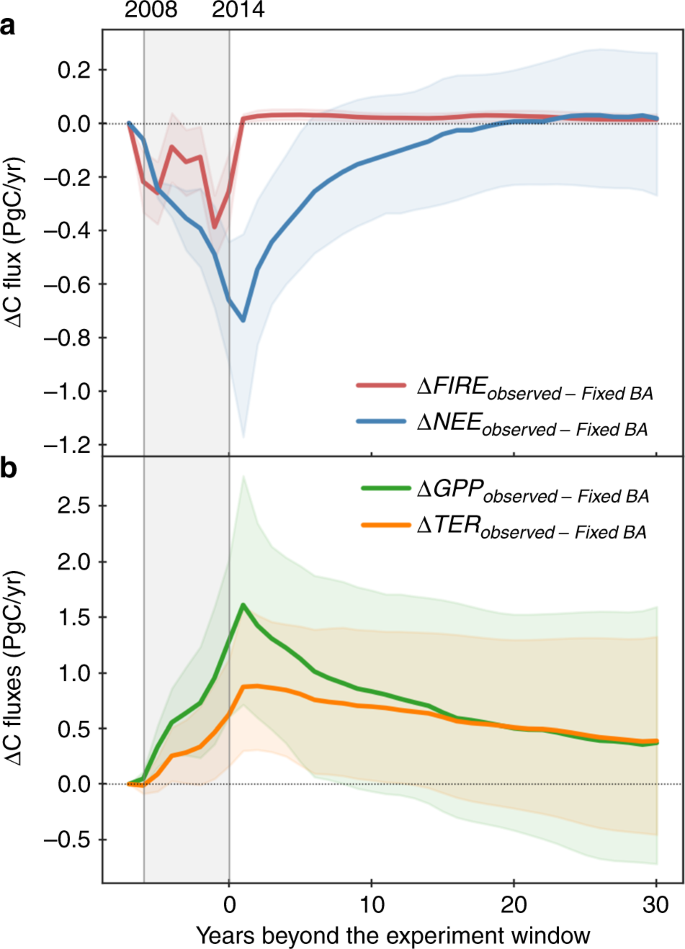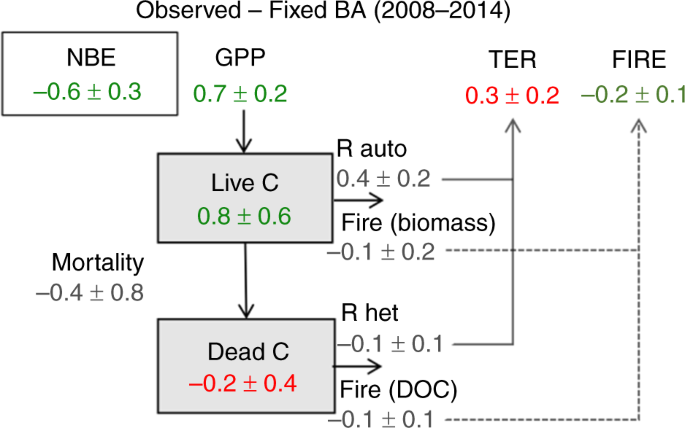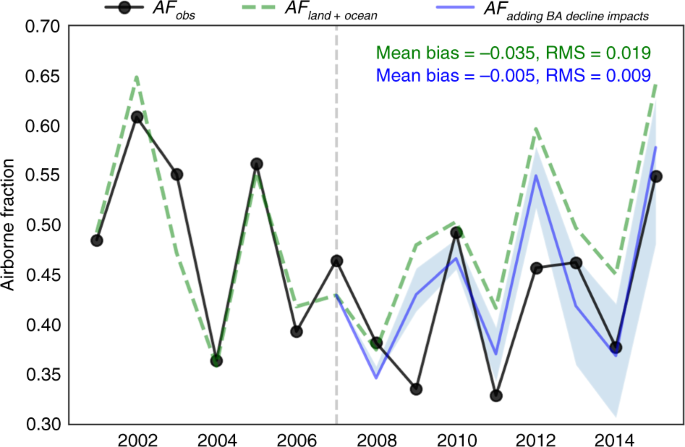Fire decline in dry tropical ecosystems enhances decadal land carbon sink
Abstract
Introduction
Results and discussion
Observed declines in burned area and fire emissions
Global BA decreased by 34 Mha per year (−9%) between 2001–2007 and 2008–2014 according to the Global Fire Emission Database (GFED4), and by 52 Mha per year (−10%) according to GFED4s that accounts for small fires using thermal active fire data in addition to the BA detected from changes in surface reflectance retrieved from the MODIS (Moderate Resolution Imaging Spectroradiometer) instrument29,30. BA declines occurred mostly in savanna (−10 Mha per year, −8%), woody savanna (−9.6 Mha per year, −7%), and grassland (−9.5 Mh per year, −21%) according to the MODIS land cover type31 (Fig. 1). The decrease of BA in the open shrubland is also large (−3.3 Mha per year, −15%) but has considerable interannual variations, whereas the decline in closed shrubland is significant but small in absolute magnitude (−0.7 Mha per year, −23%). In contrast, BA changes in forest—which have on average much lower fire frequencies—are relatively small in absolute magnitude and are associated with large interannual variations. The land cover types showing large BA declines have in general relatively short fire return times ranging from 1 year to a few years3, places showing significant decadal fire reductions are hence expected to experience changes in fire frequency and thus deviations from their typical fire disturbance-recovery trajectory. Additional BA dataset (ESA-CCI)32 that are also derived from MODIS instrument with a different algorithm shows a comparable spatial pattern as GFED4 and a decrease by 23 Mha per year (−6%) between the two periods (Supplementary Fig. 2). Relatively smaller declines are found when small fires are not explicitly considered. Here, we use GFED4s as the reference version for further analysis as it is important to account for variations in small fires to fully capture fire dynamics29.Impacts of fire decline on the subsequent carbon cycle
To quantify the impact of the observed BA decline between 2001–2007 and 2008–2014 on the carbon cycle, we performed a CARDAMOM control run with a constant 2008–2014 burned area, using average 2001–2007 burned area values. All else being equal, the simulated differences between the observation-retrieved carbon cycle states and fluxes (henceforth denoted as Observed BA) relative to the control run (henceforth denoted as Fixed BA) represent impacts of the Observed BA decline relative to the mean 2001–2007 fire levels. Fire emissions estimated using the Observed BA are 0.2 ± 0.1 PgC per year lower compared to the hypothetical case of Fixed BA averaged over 2008–2014 (Fig. 2, Fig. 3a). Beyond the 2008–2014 experiment window when all setups return to the same to evaluate the legacy effects of previous fire, differences in fire emissions between Observed BA and Fixed BA (ΔFIRE) reduced to +0.03 PgC per year averaged over 30 years. The slightly higher fire emissions associated with Observed BA result from larger fuel loads, because a lower 2008–2014 fire level had burned fewer organic matters and allowed more vegetation to regrow.Implications for the global carbon cycle
Accounting for our estimation of the fire decline impacts on the global carbon cycle relative to the case of Fixed BA at average 2001–2007 fire level, we could better explain the observed airborne fraction building on estimates of the other components from the GCP (see Methods). The adjusted airborne fraction estimates accounting for both direct and indirect effects of fire decline relative to the 2002–2007 mean significantly reduces the mean bias of the initial GCP estimates by 86% and the RMS by 53% reduction (Fig. 6). This improvement suggests that the enhancement of the land carbon sink due to fire reduction might have contributed to the global carbon budget with a magnitude comparable to the current estimates of the imbalance. It could have played a significant role in the recent terrestrial carbon sink increase, in addition to the widely recognized impacts of climate warming, CO2 fertilization, and land use change as addressed in GCP13, as well as other processes that are not explicitly accounted for. While land use change emissions do account for fire emissions, in particular, those related to deforestation and cropland conversion, and typical subsequent recovery13,16,19, the mechanisms we highlight here include the explicit representation of feedbacks between reduced fires and increased leaf area, potential limitations induced by additional growth potential through water availability, and subsequent impacts on heterotrophic respiration. Further investigation into the relative impacts of these processes is critical to improve understanding and reduce uncertainty on the response of ecosystems to reduced fire activity. We also note that although CARDAMOM results explicitly represent the role of parametric uncertainty on the reported increases in GPP and NEE, it is necessary for future efforts to investigate the role of model structural uncertainties.Methods
Satellite-derived burned area and bottom-up fire emissions
We use satellite-derived burned area (BA) from the Global Fire Emissions Database (GFED)30,46 and the ESA-CCI product32 at a spatial resolution of 0.25° and a temporal resolution of monthly. We include two versions from GFED: GFED4 based on changes in the surface reflectance, and GFED4s that, in addition to the GFED4 BA, account for small fires using active fire information to extend the detection limit47. We focus on the period from 2001 to 2014, during which the BA are consistently retrieved from MODIS and the atmospheric CO retrievals are available from MOPITT. GFED4s BA is used as the reference version in this study, while the rests are used for sensitivity tests. GFED also provides gridded monthly fire emissions from multiple fire tracers using a bottom-up approach2,46. CO emission estimates from GFED3 are used as the prior for fire emissions in our atmospheric inversion described below.Atmospheric top-down fire emissions estimates
Complementary to the ground fire features derived from satellite, trace gases emitted from biomass burning could provide valuable top-down constraints to fire emission estimates, in particular CO, because it has a relatively simple source structure (mainly from fossil fuel and biomass burning with relatively small spatial colocations) and a lifetime of a few weeks allowing the track of the transport from its source regions48. Using a two-step inversion system that combines a sequential Kalman filter to optimize boundary conditions and a variational assimilation system to optimize fluxes, we assimilate MOPITT CO retrievals (version 649) with GeosChem to optimize monthly CO emissions from fire and fossil fuel, and additional sources from hydrocarbon oxidation (details are documented in Jiang et al.23). The version of GeosChem we use here has a spatial resolution of 4° × 5° and a vertical resolution of 47 levels23. We convert MOPITT-derived fire CO emission into fire carbon emission using biome-specific ratios of emission factors between CO and the total carbon following GFED4. Uncertainties in the CO inversion and the ratio between emission factors are propagated into the uncertainty of CO-derived fire carbon emission estimates following the method in Worden et al.50. The derived fire carbon emissions and associated uncertainties are used to constraint CARDAMOM fire emissions described below.CARDAMOM: data constrained carbon cycle model
CARDAMOM represents six carbon pools (foliar, labile, wood, fine roots, litter, and soil carbon) and one plant-available water pool in each model grid, and simulates the processes controlling their dynamic evolutions in time22,51 (Supplementary Fig. 1). The forcing data consist of monthly meteorology reanalysis (ERA- interim) from European Centre for Medium-Range Weather Forecasts (ECMWF) and BA from GFED4s. The total carbon input is represented by the gross primary production (GPP), which is a function of meteorology and the photosynthetic capacity depending on foliar carbon pool; autotrophic respiration (Ra) is a function of GPP and temperature; the net primary production (NPP) is then allocated into the four live biomass pools. Plant mortality is expressed by the turnover time of each carbon pool and organic matters moved into litter or soil carbon pools are subject to further decomposition as a function of temperature and moisture (Rh). Fire is introduced by prescribed BA, causing the combustion of live biomass and dead organic matters and an increase in mortality rate. Key model parameters controlling the carbon cycle (photosynthesis, phenology, allocation, and turnover rates) and fire-related processes (combustion factors for foliar, structural, litter and soil C pools, as well as a fire resilience factor) are optimized within each grid at a 4° × 5° resolution, the same resolution as the MOPITT-CO inversion, using a Metropolis-Hastings Markov Chain Monte Carlo Approach22. The parameters are not distinguished by plant functional types (please see details in Bloom et al.22; Bloom et al.51).Deducing fire decline impacts on the airborne fraction
We convert our estimated ΔFIRE and ΔNEE fluxes between the Observed BA and the Fixed BA scenarios into equivalent changes in the airborne fraction (AF). The other budget terms are adopted from the most recent GCP global carbon budget)13. For each year, GCP synthesize CO2 emissions from fossil fuel and industry using energy statistics (EFF), land-use change emissions based on bookkeeping models (ELUC), and ocean (SOCEAN) and terrestrial carbon sinks (SLAND) based on the state-of-the-art process models (Supplementary Fig. 7). The atmospheric growth rate is directly determined by the atmospheric CO2 observations (GATM). Ideally, if every component is accurately estimated: EFF + ELUC = GATM + SOCEAN + SLAND, the observed airborne fraction, AFobs = GATM/(EFF + ELUC), would match perfectly the process-explained variations, AFland+ocean = 1 − (SOCEAN + SLAND)/(EFF + ELUC). However, due to imperfect understanding of the contemporary carbon cycle and model representation, there is a mismatch. We thus include our estimated fire impacts on ΔFIRE and ΔNEE to evaluate the updated attribution, AF+BA Decline = 1 − (SOCEAN + SLAND − ΔFIRE − ΔNEE)/(EFF + ELUC).Data availability
References
- 1.
Bowman, D. M. J. S. et al. Fire in the Earth System. Science 324, 481–484 (2009).
- 2.
van der Werf, G. R. et al. Global fire emissions and the contribution of deforestation, savanna, forest, agricultural, and peat fires (1997–2009). Atmos. Chem. Phys. 10, 11707–11735 (2010).
- 3.
Archibald, S., Lehmann, C. E. R., Gomez-Dans, J. L. & Bradstock, R. A. Defining pyromes and global syndromes of fire regimes. Proc. Natl Acad. Sci. USA 110, 6442–6447 (2013).
- 4.
Marlon, J. R. et al. Global biomass burning: a synthesis and review of Holocene paleofire records and their controls. Quat. Sci. Rev. 65, 5–25 (2013).
- 5.
Chen, Y. et al. A pan-tropical cascade of fire driven by El Niño/Southern Oscillation. Nat. Clim. Change 7, 906–911 (2017).
- 6.
van der Werf, G. R. et al. Climate regulation of fire emissions and deforestation in equatorial Asia. Proc. Natl Acad. Sci. USA 105, 20350–20355 (2008).
- 7.
van der Werf, G. R., Randerson, J. T., Giglio, L., Gobron, N. & Dolman, A. J. Climate controls on the variability of fires in the tropics and subtropics. Global Biogeochem. Cycles 22, GB3028 (2008).
- 8.
Pechony, O. & Shindell, D. T. Driving forces of global wildriers over the past millennium and the forthcoming century. Proc. Natl Acad. Sci. USA 107, 19167–19170 (2010).
- 9.
van Marle, M. J. E. et al. Historic global biomass burning emissions for CMIP6 (BB4CMIP) based on merging satellite observations with proxies and fire models (1750–2015). Geosci. Model Dev. 10, 3329–3357 (2017).
- 10.
Andela, N. et al. A human-driven decline in global burned area. Science. 356. 1356–1362 (2017).
- 11.
Zubkova, M., Boschetti, L., Abatzoglou, J. T. & Giglio, L. Changes in fire activity in Africa from 2002 to 2016 and their potential drivers. Geophys. Res. Lett. https://doi.org/10.1029/2019GL083469 (2019).
- 12.
Keenan, T. F. et al. Recent pause in the growth rate of atmospheric CO2 due to enhanced terrestrial carbon uptake. Nat. Commun. 7, 13428 (2016).
- 13.
Le Quéré, C. et al. Global carbon budget 2017. Earth Syst. Sci. Data 10, 405–448 (2018).
- 14.
Schimel, D., Stephens, B. B. & Fisher, J. B. Effect of increasing CO2 on the terrestrial carbon cycle. Proc. Natl Acad. Sci. USA 112, 436–441 (2015).
- 15.
Ballantyne, A. et al. Accelerating net terrestrial carbon uptake during the warming hiatus due to reduced respiration. Nat. Clim. Change 7, 148–152 (2017).
- 16.
Piao, S. et al. Lower land-use emissions responsible for increased net land carbon sink during the slow warming period. Nat. Geosci. https://doi.org/10.1038/s41561-018-0204-7 (2018).
- 17.
Liu, J. et al. Contrasting carbon cycle responses of the tropical continents to the 2015–2016 El Niño. Science 358, eaam5690 (2017).
- 18.
Yin, Y. et al. Variability of fire carbon emissions in Equatorial Asia and its non-linear sensitivity to El Niño. Geophys. Res. Lett., https://doi.org/10.1002/2016GL070971 (2016).
- 19.
Houghton, R. A. et al. Carbon emissions from land use and land-cover change. Biogeosciences 9, 5125–5142 (2012).
- 20.
Kashian, D. M., Romme, W. H., Tinker, D. B., Turner, M. G. & Ryan, M. G. Carbon storage on landscapes with stand-replacing fires. Bioscience 56, 598–606 (2006).
- 21.
Luo, Y. & Weng, E. Dynamic disequilibrium of the terrestrial carbon cycle under global change. Trends Ecol. Evol. 26, 96–104 (2011).
- 22.
Bloom, A. A., Exbrayat, J.-F., van der Velde, I. R., Feng, L. & Williams, M. The decadal state of the terrestrial carbon cycle: Global retrievals of terrestrial carbon allocation, pools, and residence times. Proc. Natl Acad. Sci. USA. https://doi.org/10.1073/pnas.1515160113 (2016).
- 23.
Jiang, Z. et al. A 15-year record of CO emissions constrained by MOPITT CO observations. Atmos. Chem. Phys. 17, 4565–4583 (2017).
- 24.
Akagi, S. K. et al. Emission factors for open and domestic biomass burning for use in atmospheric models. Atmos. Chem. Phys. 11, 4039–4072 (2011).
- 25.
Myneni, R., Knyazikhin, Y., DAAC. & Park, T. MOD15A2 MODIS/Terra Leaf Area Index/FPAR 8-Day L4 Global 1km SIN Grid. (Boston University. MODAPS SIPS – NASA, 2015) https://doi.org/10.5067/MODIS/MOD15A2.006.
- 26.
Parazoo, N. C. et al. Terrestrial gross primary production inferred from satellite fluorescence and vegetation models. Glob. Change Biol. 20, 3103–3121 (2014).
- 27.
Saatchi, S. S. et al. Benchmark map of forest carbon stocks in tropical regions across three continents. Proc. Natl Acad. Sci. USA 108, 9899–9904 (2011).
- 28.
Hiederer, R. & Köchy, M. Global soil organic carbon estimates and the harmonized world soil database. EUR 79, 25225 (2011).
- 29.
Randerson, J. T., Chen, Y., van der Werf, G. R., Rogers, B. M. & Morton, D. C. Global burned area and biomass burning emissions from small fires. J. Geophys. Res. 117, G04012 (2012).
- 30.
Giglio, L., Randerson, J. T. & van der Werf, G. R. Analysis of daily, monthly, and annual burned area using the fourth-generation global fire emissions database (GFED4). J. Geophys. Res. Biogeosci. 118, 317–328 (2013).
- 31.
Friedl, M. A. et al. MODIS Collection 5 global land cover: algorithm refinements and characterization of new datasets. Remote Sens. Environ. 114, 168–182 (2010).
- 32.
Chuvieco, E. et al. Generation and analysis of a new global burned area product based on MODIS 250 m reflectance bands and thermal anomalies. Earth Syst. Sci. Data 10, 2015–2031 (2018).
- 33.
Carvalhais, N. et al. Global covariation of carbon turnover times with climate in terrestrial ecosystems. Nature 514, 213–217 (2014).
- 34.
Song, X.-P. et al. Global land change from 1982 to 2016. Nature 560, 639–643 (2018).
- 35.
Baccini, A. et al. Tropical forests are a net carbon source based on aboveground measurements of gain and loss. Science 358, 230–234 (2017).
- 36.
Pellegrini, A. F. A. et al. Fire frequency drives decadal changes in soil carbon and nitrogen and ecosystem productivity. Nature 553, 194–198 (2018).
- 37.
McSherry, M. E. & Ritchie, M. E. Effects of grazing on grassland soil carbon: a global review. Glob. Change Biol. 19, 1347–1357 (2013).
- 38.
Bond, W. J. & Keeley, J. Fire as a global ‘herbivore’: the ecology and evolution of flammable ecosystems. Trends Ecol. Evol. 20, 387–394 (2005).
- 39.
Pellegrini, A. F. A., Hedin, L. O., Staver, A. C. & Govender, N. Fire alters ecosystem carbon and nutrients but not plant nutrient stoichiometry or composition in tropical savanna. Ecology 96, 1275–1285 (2015).
- 40.
Hicke, J. A. et al. Postfire response of North American boreal forest net primary productivity analyzed with satellite observations. Glob. Change Biol. 9, 1145–1157 (2003).
- 41.
Wang, Z., Chappellaz, J., Park, K. & Mak, J. E. Large variations in southern hemisphere biomass burning during the last 650 Years. Science 330, 1663–1666 (2010).
- 42.
van der Werf, G. R., Peters, W., van Leeuwen, T. T. & Giglio, L. What could have caused pre-industrial biomass burning emissions to exceed current rates? Clim 9, 289–306 (2013).
- 43.
Arora, V. K. & Melton, J. R. Reduction in global area burned and wildfire emissions since 1930s enhances carbon uptake by land. Nat. Commun. 9, 1326 (2018).
- 44.
Kolby Smith, W. et al. Large divergence of satellite and Earth system model estimates of global terrestrial CO2 fertilization. Nat. Clim. Change 6, 306–310 (2016).
- 45.
Fernández-Martínez, M. et al. Global trends in carbon sinks and their relationships with CO2 and temperature. Nat. Clim. Change 9, 73–79 (2019).
- 46.
van der Werf, G. R. et al. Global fire emissions estimates during 1997-2016. Earth Syst. Sci. Data 9, 697–720 (2017).
- 47.
Giglio, L., Loboda, T., Roy, D. P., Quayle, B. & Justice, C. O. An active-fire based burned area mapping algorithm for the MODIS sensor. Remote Sens. Environ. 113, 408–420 (2009).
- 48.
Yin, Y. et al. Decadal trends in global CO emissions as seen by MOPITT. Atmos. Chem. Phys. 15, 13433–13451 (2015).
- 49.
Deeter, M. N. et al. The MOPITT Version 6 product: algorithm enhancements and validation. Atmos. Meas. Tech. 7, 3623–3632 (2014).
- 50.
Worden, J. R. et al. Reduced biomass burning emissions reconcile conflicting estimates of the post-2006 atmospheric methane budget. Nat. Commun. 8, 2227 (2017).
- 51.
Bloom, A. A. & Williams, M. Constraining ecosystem carbon dynamics in a data-limited world: integrating ecological “common sense” in a model–data fusion framework. Biogeosciences 12, 1299–1315 (2015).

